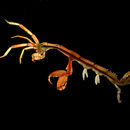en
names in breadcrumbs


Length: 6-49mm. Head rounded. Most extreme body projections described here (fully developed adult male): Cephalon and pereonite 1 smooth (although with dense long setae, which also extend over gnathopod 2); pereonite 2 with 1-3 pairs dorsal spines and 2 pairs lateral spines (base of gnathopods 2 and posterior); pereonite 3 with 7 pairs dorsal spines and 3-7 spines near attachment of gills; pereonite 4 with 8 pairs dorsal spines and 3-7 spines near attachment of gills, 1 pair lateral spines at both anterior and posterior margin; pereonite 5 with 5 pairs dorsal spines, 1 pair antero-lateral spines; pereonites 6 and 7 with 2 pairs of spines dorsally (median and posterior). Antenna 1 longer than ½ body length. Antenna 2 less than ½ length of antenna 1; peduncle with two ventral rows of setae. Gnathopod 1 short, with setation on posterior margin; propodus with 2 grasping spines, grasping margin of dactylus and propodus serrate. Gnathopod 2 long, densely covered in setae; propodus palm with large projection proximo-medial and a distal triangular projection ; dactylus heavy and scimitar-shaped; basis having an antero-lateral projection distally. Gills oval to elliptical. Pereopods 5 - 7 propodus with 2 grasping spines. Females differ in presence of 1 pair spines on cephalon and posterior of pereonite 1 (not always present)
Native to Sea of Japan (Russia and Japan); introduced widely in northern hemisphere and New Zealand in the southern hemisphere.
Caprellid, "Ghost" or "Skeleton" shrimps, so called for their skeletal appearance. Amphipod crustaceans, easily distinguished by the elongate stick-like body form and reduction of the abdominal appendages. Head is generally fused with pereonite 1. Pereopods on first 2 segments (pereonites) are most flexible and called gnathopods; gnathopods 2 being the largest, used in defense, feeding and substrate attachment. In many species pereopods 3 and 4 may also be reduced or absent. Gills on pereonites 3 + 4, rarely on pereonite 2. Pereopods 5 - 7 much smaller than 1 + 2, used for clinging to the substratum. In females, brood plates (öostegites) develop on pereonites 3 + 4. Much remains to be learnt about their biology, ecology and in many cases changing distributions.
In fouling communities on floats and pilings, on many substrates (hydroids, bryozoans, ascidians etc.)
Introduced throughout the northern hemisphere and to New Zealand in the southern hemisphere. Very abundant during summer months. Distinguished from C. acanthogaster: pereonite 2+3 covered in fine setae in mature male, gnathopod 2 poison spine less developed, gills are shorter.
National Museum of Natural History, Washington DC: (NMNH); University of Alaska, Fairbanks